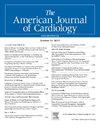经导管自扩张心脏瓣膜置换术后环大小对生物假体瓣膜失效的影响。
IF 2.1
3区 医学
Q2 CARDIAC & CARDIOVASCULAR SYSTEMS
引用次数: 0
摘要
关于小主动脉环(SAA)和大主动脉环(LAA)患者经导管主动脉瓣置换术(TAVR)后的预后和长期瓣膜耐久性的证据有限。本分析旨在评估环形瓣膜大小差异对患者和瓣膜预后的影响。回顾性分析1211例采用自扩式经导管心脏瓣膜(SE-THV)行TAVR的患者。SAA的截止值定义为环空周长< 72 mm。主要终点是SAA组和LAA组的全因死亡率和生物假体瓣膜衰竭(BVF)。作为亚分析,还评估了术后平均压力梯度(mPG)≥20mmHg和严重假体-患者不匹配(PPM)对这些结果的影响。在所有患者中,60.1% (n=723)有SAA。在TAVR后7年,SAA组的全因死亡率低于LAA组(53.7%比63.7%,log-rank p=0.05), BVF发生率低于LAA组(1.2%比4.6%,Gray检验p=0.01)。多因素Cox-regression和Fine-Gray竞争风险回归分析显示,SAA的存在与较好的预后(风险比[HR]: 0.81, 95%可信区间[CI]: 0.67 ~ 0.98)和较低的BVF(调整后亚分布HR, 0.41;95% CI, 0.17 ~ 0.98)。术后mPG≥20 mmHg或重度PPM对死亡率和BVF的差异无影响。此外,这些结果在SAAs患者中也是一致的。综上所述,SE-THV TAVR术后SAA患者的长期预后和瓣膜耐久性较好。本文章由计算机程序翻译,如有差异,请以英文原文为准。
Impact of Annulus Size on Bioprosthetic Valve Failure after Self-Expanding Transcatheter Heart Valves Replacement
There is limited evidence on the prognosis and long-term valve durability after transcatheter aortic valve replacement (TAVR) in patients with small aortic annulus (SAA) and large aortic annulus (LAA). This analysis was sought to evaluate the impact of annular size differences on patients’ and valve outcomes. A total of 1,211 patients undergoing TAVR using self-expandable transcatheter heart valve (SE-THV) were retrospectively analyzed. The cut-off for SAA was defined as annulus perimeter of < 72 mm. The primary endpoints were all-cause mortality and bioprosthetic valve failure (BVF) between the SAA and LAA groups. As a sub-analysis, the impact of postprocedural mean pressure gradient (mPG) ≥ 20mmHg and severe prosthesis-patient mismatch (PPM) on these outcomes were also evaluated. Of all patients, 60.1% (n = 723) had SAA. At 7 years after TAVR, the SAA group had lower incidence of all-cause mortality (53.7% vs 63.7%, log-rank p = 0.05) and lower event rate of BVF than LAA (1.2% vs 4.6%, p = 0.01 for Gray’s test). Multivariate Cox-regression and Fine-Gray competing risk regression analysis demonstrated the presence of SAA was related to better prognosis (Hazard ratio [HR]: 0.81, 95% confidence interval [CI]: 0.67 to 0.98) and lower BVF (adjusted subdistribution HR, 0.41; 95% CI, 0.17 to 0.98). There were no impact of postprocedural mPG ≥ 20 mmHg or severe PPM on the difference of mortality and BVF. Further, these results were consistent in the patients with SAAs. In conclusion, SAA had better long-term patients’ prognosis and valve durability after TAVR with SE-THV.
求助全文
通过发布文献求助,成功后即可免费获取论文全文。
去求助
来源期刊

American Journal of Cardiology
医学-心血管系统
CiteScore
4.00
自引率
3.60%
发文量
698
审稿时长
33 days
期刊介绍:
Published 24 times a year, The American Journal of Cardiology® is an independent journal designed for cardiovascular disease specialists and internists with a subspecialty in cardiology throughout the world. AJC is an independent, scientific, peer-reviewed journal of original articles that focus on the practical, clinical approach to the diagnosis and treatment of cardiovascular disease. AJC has one of the fastest acceptance to publication times in Cardiology. Features report on systemic hypertension, methodology, drugs, pacing, arrhythmia, preventive cardiology, congestive heart failure, valvular heart disease, congenital heart disease, and cardiomyopathy. Also included are editorials, readers'' comments, and symposia.
 求助内容:
求助内容: 应助结果提醒方式:
应助结果提醒方式:


